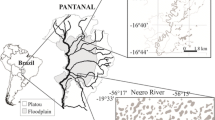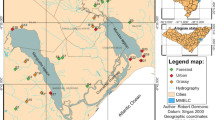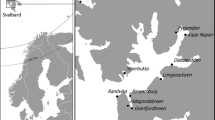Abstract
Amazonian floodplain lakes, which are of different types based on their proximity to the main river channels, are subjected to a strong seasonal hydrologic cycle and have different habitat types within them. We hypothesized that these two spatial scales (lake type, and habitat type within lakes), and the temporal scale associated with hydrological seasons help explain the high fish diversity of the Amazon basin. We sampled three lake types categorized by proximity and connectivity with the Solimões River (island, coastal, and mainland) in 2011 during both high and low water seasons. Within these lakes, we sampled three habitat types (open water, flooded forest, and macrophyte banks). Although comparisons of diversity indices revealed few differences with respect to overall species numbers, actual species composition, which is not included in calculation of diversity indices, differed markedly at all three scales. Although many species (86) were common to all three types of lakes, each type also had many unique species (11–20), as did within-lake habitat type (10–15) and hydrologic season (26 each). Thus, these temporal and spatial scales are important to the detection and understanding of fish species diversity in this region, and will be important to keep in mind when designing preserves.




Similar content being viewed by others
References
Agostinho, A. A., L. C. Gomes & M. Zalewski, 2001. The importance of floodplains for the dynamics of fish communities of the upper river Paraná. Ecohydrology & Hydrobiology 1: 209–217.
Anderson, M., 2001. A new method for non-parametric multivariate analysis of variance. Austral Ecology 26: 32–46.
Araújo-Lima, C. A. R. M. & M. Goulding, 1998. So fruitful a fish: ecology, conservation and aquaculture of the Amazon’s tambaqui. Columbia University Press, New York.
Arrington, D. A. & K. O. Winemiller, 2006. Habitat affinity, the seasonal flood pulse, and community assembly in the littoral zone of a Neotropical floodplain river. Journal of the North American Benthological Society 25: 126–141.
Baselga, A., 2010. Partitioning the turnover and nestedness components of beta diversity. Global Ecology and Biogeography 19: 134–143.
Baselga, A., A. Jimenez-Valverde & G. Niccolini, 2007. A multiple-site similarity measure independent of richness. Biology Letters 3: 642–645.
Baselga, A., D. Orme, S. Villeger, J. De Bortoli & F. Leprier, 2013. Betapart: Partitioning beta diversity into turnover and nestedness components. v. 1.3. https://cran.r-project.org/web/packages/betapart/betapart.pdf.
Batista, V. S., A. J. Inhamuns, C. E. C. Freitas & D. Freire-Brasil, 1998. Characterization of the fishery in riverine communities in the Low-Solimões/High-Amazon region. Fisheries Management and Ecology 5: 419–435.
Borcard, D., F. Gillet & P. Legendre, 2011. Numerical Ecology with R. Springer, New York.
Campos, C. P., R. C. S. Garcez, M. Catarino, G. A. Costa & C. E. C. Freitas, 2015. Population dynamics and stock assessment of Colossoma macropomum caught in Manacapuru lake system (Amazon Basin, Brazil). Fisheries Management and Ecology 22: 400–406.
Castello, L. & M. N. Macedo, 2015. Large-scale degradation of Amazonian freshwater ecosystems. Global Change Biology. doi:10.1111/gcb.13173.
Castello, L., D. G. McGrath, L. L. Hess, M. T. Coe, P. A. Lefebvre, P. Petry, M. N. Macedo, V. F. Reno & C. C. Arantes, 2013. The vulnerability of Amazon freshwater ecosystems. Conservation Letters 6: 217–229.
Claro-Jr, L., E. Ferreira, J. A. Zuanon & C. A. R. M. Araújo-Lima, 2004. O efeito da floresta alagada na alimentação de três espécies de peixes onívoros em lagos de várzea da Amazônia Central, Brasil. Acta Amazonica 34: 133–137.
Colwell, R. K. & J. A. Coddington, 1994. Estimating terrestrial biodiversity through extrapolation. Philosophical Transactions of the Royal Society B. Biological Sciences 345: 101–118.
Cornell, H. V., L. E. Hurd & V. A. Lotrich, 1976. A measure of response to perturbation used to assess structural change in some polluted and unpolluted stream fish communities. Oecologia 23: 335–342.
Correa, S. B., W. G. R. Crampton, L. J. Chapman & J. S. Albert, 2008. A comparison of flooded forest and floating meadow fish assemblages in an upper Amazon floodplain. Journal of Fish Biology 72: 629–644.
Cox-Fernandes, C., 1997. Lateral migration of fishes in Amazon floodplains. Ecology of Freshwater Fish 6: 36–44.
Fernandes, R., L. C. Gomes, F. M. Pelicice & A. A. Agostinho, 2009. Temporal organization of fish assemblages in floodplain lagoons: the role of hydrological connectivity. Environmental Biology Fishes 85: 99–108.
Finer, M. & C. N. Jenkins, 2012. Proliferation of hydroelectric dams in the Andean Amazon and its implications for Andes-Amazon connectivity. PloS One 7: 1–9.
Forsberg, B. R., C. A. R. M. Araújo-Lima, L. A. Martinelli, R. L. Victoria & J. A. Bonassi, 1993. Autotrophic carbon sources for fish of the Central Amazon. Ecology 74: 643–652.
Freitas, C. E. C., F. K. Siqueira-Souza, A. R. Guimarães, F. A. Santos & I. L. A. Santos, 2010a. Interconnectedness during high water maintains similarity in fish assemblages of island floodplain lakes in the Amazonian Basin. Zoologia 27: 931–938.
Freitas, C. E. C., F. K. Siqueira-Souza, K. L. L. Prado, K. C. Yamamoto & L. E. Hurd, 2010b. Factors determining fish species diversity in Amazonian floodplain lakes. In Rojas, N. & R. Prieto (eds), Amazon basin: plant life, wildlife and environment. Science Publishers, Nova York: 41–76.
Freitas, C. E. C., F. K. Siqueira-Souza, A. C. Florentino & L. E. Hurd, 2013a. The importance of spatial scales to analysis of fish diversity in Amazonian floodplain lakes and implications for conservation. Ecology of Freshwater Fish 23: 470–477.
Freitas, C. E. C., F. K. Siqueira-Souza, R. Humston & L. E. Hurd, 2013b. Assessing drought sensitivity of Amazonian floodplain fish communities. Hydrobiologia 705: 159–171.
Goulding, M., 1980. The fishes and the forest: Explorations in Amazonian natural history. University of California Press, Berkeley, LA.
Hoeinghaus, D. J., C. A. Layman, D. A. Arrington & K. O. Winemiller, 2003. Spatiotemporal variation in fish assemblage structure in tropical floodplain creeks. Environmental Biology of Fishes 67: 379–387.
Hommel, G., 1988. A stagewise rejective multiple test procedure based on a modified bonferroni test. Biometrika 75: 383–386.
Hurd, L. E., R. G. C. Souza, F. K. Siqueira-Souza, G. J. Cooper, J. R. Kahn & C. E. C. Freitas, 2016. Amazon floodplain fish communities: habitat connectivity and conservation in a rapidly deteriorating environment. Biological Conservation 195: 118–127.
Jenkins, M., 2003. Prospects for biodiversity. Science 302: 1175–1177.
Junk, W. J. & M. T. F. Piedade, 1997. Plant life in the floodplain with special reference to herbaceous plants. In Junk, W. J. (ed.), The central amazon floodplain: Ecology of a pulsing system. Ecological Studies. Springer, Berlin: 147–186.
Junk, W. J. & B. Robertson, 1997. Aquatic invertebrates. In Junk, W. J. (ed.), The central amazon floodplain: Ecology of a pulsing system. Ecological Studies. Springer, Berlin: 279–298.
Junk, W. J., P. B. Bayley & R. E. Sparks, 1989. The flood pulse concept in river-floodplains systems. In Dodge D. P. (ed.) Proceedings of the International Large River Symposium. Canadian Special Publication of Fisheries and Aquatic Science, vol. 106, pp. 110–127.
Junk, W. J., M. G. Soares & U. Saint-Paul, 1997. The fish. In Junk, W. J. (ed.), The central amazon floodplain: Ecology of a pulsing system. Ecological Studies. Springer, Berlin: 385–408.
Lowe-McConnell, R., 1999. Estudos ecológicos em comunidades de peixes tropicais. EDUSP, São Paulo, SP, 524 pp.
Marengo, J. A., C. A. Nobre, J. Tomasella, M. D. Oyama, G. S. R. de Oliveira, R. de Oliveira, H. Camargo, L. M. Alves & I. F. Brown, 2008. The drought of Amazonia in 2005. Journal of Climatology 21: 495–516.
Martelo, J., K. Lorenzen, M. Crossa & D. McGrath, 2008. Habitat associations of exploited fish species in the Lower Amazon river-floodplain system. Freshwater Biology 53: 2455–2464.
Mendonça, F., V. Pazin, H. Espírito-Santo, J. A. Zuanon & W. E. Magnusson, 2008. Peixes. In M. L. Oliveira, F. B. Baccaro, R. Braga-Neto, W. E. (eds) Magnusson (Org.) Reserva Ducke—A biodiversidade amazônica através de uma grade, pp. 63–75.
Miyazono, S., J. N. Aycock, L. E. Miranda & T. E. Tietjen, 2010. Assemblage patterns of fish functional groups relative to habitat connectivity and conditions in floodplain lakes. Ecology of Freshwater Fish 19(578): 585.
Mojica, J. L., C. Castellanos & J. Lobón-Cerviá, 2009. High temporal species turnover enhances the complexity of fish assemblages in Amazonian terra firme streams. Ecology of Freshwater Fish 18: 520–526.
Oksanen, J., F. Guillaume Blanchet, R. Kindt, P. Legendre, R. B. O’Hara, G. L. Simpson, P. Solymos, M. H. H. Stevens & H. Vagner, 2011. Vegan: Community Ecology Package version 1.17-9. http://CRAN.R-project.org/package=vegan
Petry, A. C., A. A. Agostinho & L. C. Gomes, 2003a. Fish assemblages of tropical floodplain lagoons: exploring the role of connectivity in a dry year. Neotropical Ichthyology 1: 111–119.
Petry, P., P. B. Bayley & D. F. Markle, 2003b. Relationships between fish assemblages, macrophytes and environmental gradients in the Amazon River floodplain. Journal of Fish Biology 63: 547–579.
Petry, A. C., L. C. Gomes, P. Piana & A. A. Agostinho, 2010. The role of the predatory trahira (Pisces: Erythrinidae) in structuring fish assemblages in lakes of a Neotroplical floodplain. Hydrobiologia 651: 115–126.
Pittock, J., L. J. Hansen & R. Abell, 2008. Running dry: freshwater biodiversity, protected areas and climate change. Biodiversity 9: 30–39.
Qian, H., R. E. Ricklefs & P. White, 2005. Beta diversity of angiosperms in temperate floras of eastern Asia and eastern North America. Ecology Letters 8: 15–22.
R 2.14.2. R Development Core Team, 2012. R: A language and environmental for statistical computing. R Foundation for Statistical Computing. Vienna, Austria. ISBN 3-900051-07-0. http://CRAN.Rproject.org.
Reis, R. E., S. O. Kullander & C. J. Ferraris Jr, 2003. Check list of the freshwater fishes of South and Central America. Edipucrs, Porto Alegre.
Rodríguez, M. A. & W. M. Lewis Jr, 1997. Structure of fish assemblages along environmental gradients in floodplain lakes of the Orinoco River. Ecological Monographs 67: 109–128.
Saint-Paul, U., J. A. Zuanon, M. A. V. Correa, M. Garcia, N. N. Fabré, U. Berger & W. J. Junk, 2000. Fish communities in central Amazonian white and blackwater floodplains. Environmental Biology of Fishes 57: 235–250.
Sánchez-Botero, J. I. & C. A. R. M. Araújo-Lima, 2001. As macrófitas aquáticas como berçário para a ictiofauna da várzea do rio Amazonas. Acta Amazonica 3: 437–448.
Scarabotti, P. A., J. A. López & M. Pouilly, 2011. Flood pulse and the dynamics of fish assemblage structure from neotropical floodplain lakes. Ecology of Freshwater Fish 20: 605–618.
Siqueira-Souza, F. K. & C. E. C. Freitas, 2004. Fish diversity of floodplain lakes on the lower stretch of the Solimões river. Brazilian Journal of Biology 64: 501–510.
Soares, L. C., 1977. Hidrografia. Geografia do Brasil. Região Norte. IBGE, Rio de Janeiro: 95–166.
Soares, M. G. M., E. L. Costa, F. K. Siqueira-Souza, H. D. B. Anjos, K. C. Yamamoto & C. E. C. Freitas, 2007. Peixes de lagos do médio rio Solimões. EDUA, Manaus.
Soares, M.G.M., F. R. Silva, H. D. B. Anjos, L. Prestes, D. R. Bevilacqua & C. Campos, 2009. Ambientes de pesca e a ictiofauna do complexo lacustre do lago Grande de Manacapuru, AM: composição taxonômica e parâmetros populacionais. In Fraxe, T. J. P. & A. C. Witkoski (org), A pesca na Amazônia Central: Ecologia, conhecimento tradicional e formas de manejo. EDUA, Manaus, pp. 77–178.
Súarez, Y. R., M. Petrere-Jr & A. C. Catella, 2004. Factors regulating diversity and abundance of fish communities in Pantanal lagoons, Brazil. Fisheries Management and Ecology 11: 45–50.
Taylor, C. M. & M. L. Warren Jr, 2001. Dynamics in species composition of stream fish assemblages: Environmental variability and nested subsets. Ecology 82: 2320–2330.
Thomaz, S. M., L. M. Bini & R. L. Bozelli, 2007. Floods increase similarity among aquatic habitats in river-floodplain systems. Hydrobiologia 579: 1–13.
van de Wolfshaar, K. E., H. Middelkoop, E. Addink, H. V. Winter & L. A. J. Nagelkerke, 2011. Linking flow regime, floodplain lake connectivity and fish catch in a large river-floodplain system, the Volga-Akhtuba floodplain (Russian Federation). Ecosystems 14: 920–934.
Acknowledgements
We thank I. Santos, W. Dias, J. Pena, and L. Santos for help in field work and J. Zuanon (INPA) and K. Yamamoto (UFAM) for contribution in identification of fish. The first author was supported by a CAPES PhD scholarship: Process BEX: 9706/11-9. Additional support came from Project CNPq No. 563073/2010-1, Piatam Project (FINEP) and from a Brazilian research fellowship from CAPES and Lenfest grants from Washington and Lee University to LEH.
Author information
Authors and Affiliations
Corresponding author
Additional information
Handling editor: Luiz Carlos Gomes
Electronic supplementary material
Below is the link to the electronic supplementary material.
Rights and permissions
About this article
Cite this article
Siqueira-Souza, F.K., Freitas, C.E.C., Hurd, L.E. et al. Amazon floodplain fish diversity at different scales: do time and place really matter?. Hydrobiologia 776, 99–110 (2016). https://doi.org/10.1007/s10750-016-2738-2
Received:
Revised:
Accepted:
Published:
Issue Date:
DOI: https://doi.org/10.1007/s10750-016-2738-2




